A Novel Open-Source Simulator Of Electric Vehicles in a Demand-Side Management Scenario †
Abstract
1. Introduction
2. State of the Art
3. Materials and Methods
3.1. Cloud-Based Tool
3.1.1. Configuration
- -
- Car model
- -
- Battery capacity (kWh)
- -
- Declared vehicle autonomy (km)
- -
- Average vehicle fuel consumption (kWh/km)
- -
- Domestic charging point capacity (kW)
3.1.2. Simulation Engine
- 1.
- Night: The customer charges his/her EV until it reaches a SOC of 100% or until plugout time. Depending on the commuting distance plus a percentage buffer, the domestic recharging device simulates the minimal quantity of charge that would allow the customer to cover the expected mileage for the next day.
- 2.
- Morning: The consumer travels from his/her dwelling to the workplace. The plugout time is generated from the morning plugout probability distribution. Traffic conditions are computed to positively or negatively affect the actual energy consumption as shown in (1) and (2):Where d is the commuting distance traveled by the customer, models how much the traffic conditions affect the actual distance, is a normal distribution with as the traffic variance parameter (expressed in km), and k is a control parameter ( and k can be changed in the Advanced Options form). When , then , and traffic conditions are forced to be “adverse”. When then , hence traffic conditions are forced to be “favorable”. When then and no variability is applied. When a user does not set the parameter k, the formula becomes:
- 3.
- Lunchtime: This event may happen only if a customer has a low commuting distance and is pseudo-randomly triggered. In such case, the customer will consider a brief EV recharge during lunchtime, with an operation analogous to the “Night” phase. After this time lapse, the customer will return to the workplace as in the “Morning” phase. This step requires a further computation of , since the customer actively travels toward home and back again (to the workplace) to have lunch and charge the EV.
- 4.
- Afternoon: This phase is triggered pseudo-randomly; the customer may decide to recharge his/her EV in a public charging station for a variable time lapse before the trip home from the workplace. This could affect the SOC of the vehicle for the evening plugin.
- 5.
- Evening: The consumer travels home a distance equal to and plugs the vehicle into the home charging station according to the evening plugin probability distribution.
3.1.3. Output Graphs
3.1.4. Output Files
- Power: Power supplied to the EV (or fleet of EVs) expressed in kW.
- Energy: Energy supplied to the EV (or fleet of EVs) expressed in kWh.
- SOC: State of charge of the EV (or fleet of EVs) expressed in kWh.
- MINSOC: Represents the minimal amount of SOC that should be present in the EV battery (or fleet of EV batteries) for each time instant, in order to ensure the user required minimal SOC by the time of plugout. Expressed in kWh.
- FLEXIBILITY UP: Amount of energy of the EV (or fleet of EVs) potentially available to the grid for each time instant, expressed in kWh.
- FLEXIBILITY DOWN: Amount of energy the grid can potentially supply to the EV (or fleet of EVs) for each time instant, expressed in kWh.
- PLUGIN/PLUGOUT: Plugin and plugout events for each EV in the fleet expressed in simulator time index and date-time format.
3.2. Simulink Online Block
3.2.1. Configuration
- 1.
- Run a batch simulation on the cloud-based tool with the chosen parameters, sampling time, number of vehicles and number of days and download the resulting json files.
- 2.
- Run Initializer.m on MATLAB to populate the workspace with the Simulink dependencies and variables.
3.2.2. Aggregator Online Assistant Core Logic
3.2.3. AOA Inputs
- Power: an array of power values (kW) used as charging/discharging setpoints of the charging stations. The length of the array is equal to the number of EVs considered and each element of the array will refer to a particular EV.
- -
- Positive values will be considered as a charging action for the given time instant in a G2V strategy. If the power value exceeds the capability of the given consumer’s station it is saturated to the maximum.
- -
- Negative values are treated as a discharge action for the given time instant in a V2G strategy.
- -
- Zeroes are treated as an “hold on” command. The given EV will neither discharge nor recharge for the given time instant.
- -
- NaNs (Not a Number) are treated as a “maximum power” instruction. The given EV will recharge at the maximum power allowed (as the cloud-based tool does).
3.2.4. AOA Outputs
- Power: As for the input, this is an ordered array containing the actual charged/discharged power for each EV at the given time instant.
- SOC: Ordered array of each EV’s actual state of charge expressed in % value with respect to the maximum Battery Capacity.
- Time Until Plugout: Ordered array where each value represents the remaining time instants until the given EV will be plugged out. In case an EV is not plugged in the corresponding value is zero.
- Minimal SOC: Ordered array representing the minimum amount of SOC required by each EV at the given time instant in order to satisfy the user’s requirements at the plugout time (Time Until Plugout). In case the EV is not plugged in at the time this array is read, the respective returned value is zero.
- Battery Capacity: Ordered array containing the maximum battery capacity for each EV in terms of kWh. This array contains constant values for the whole simulation time. Future updates will allow the variability of this parameter for each EV in order to model (or to externally predict) the battery state of health degradation.
- Home Recharging Capability: Ordered array containing the maximum home charging station power (kW). This array contains constant values for the whole simulation time.
4. Case Study
4.1. Fuzzy Inference
4.2. Results
5. Conclusions
Author Contributions
Funding
Institutional Review Board Statement
Informed Consent Statement
Data Availability Statement
Conflicts of Interest
References
- International Energy Agency (IEA). Global EV Outlook 2019: Scaling up the Transition to Electric Mobility. Available online: https://www.iea.org/reports/global-ev-outlook-2019 (accessed on 20 February 2020).
- Expert Group 3 (EG3). Final Report: Demand Side Flexibility, Perceived Barriers and Proposed Recommendations. European Smart Grid Task Force, EU Commission April 2019. Available online: https://ec.europa.eu/energy/sites/ener/files/documents/eg3_final_report_demand_side_flexiblity_2019.04.15.pdf (accessed on 23 February 2021).
- Ciabattoni, L.; Comodi, G.; Ferracuti, F.; Foresi, G. AI-Powered Home Electrical Appliances as Enabler of Demand-Side Flexibility. IEEE Consum. Electron. Mag. 2020, 9, 72–78. [Google Scholar] [CrossRef]
- Tan, K.M.; Ramachandaramurthy, V.K.; Yong, J.Y. Integration of electric vehicles in smart grid: A review on vehicle to grid technologies and optimization techniques. Renew. Sustain. Energy Rev. 2016, 53, 720–732. [Google Scholar] [CrossRef]
- Rodríguez-Molina, J.; Castillejo, P.; Beltran, V.; Martínez-Núñez, M. A Model for Cost-Benefit Analysis of Privately Owned Vehicle-to-Grid Solutions. Energies 2020, 13, 5814. [Google Scholar] [CrossRef]
- Di Somma, M.; Ciabattoni, L.; Comodi, G.; Graditi, G. Managing plug-in electric vehicles in eco-environmental operation optimization of local multi-energy systems. Sustain. Energy Grids Netw. 2020, 23, 100376. [Google Scholar] [CrossRef]
- Kern, T.; Dossow, P.; von Roon, S. Integrating Bidirectionally Chargeable Electric Vehicles into the Electricity Markets. Energies 2020, 13, 5812. [Google Scholar] [CrossRef]
- Mohammad, A.; Zamora, R.; Lie, T.T. Integration of Electric Vehicles in the Distribution Network: A Review of PV Based Electric Vehicle Modelling. Energies 2020, 13, 4541. [Google Scholar] [CrossRef]
- Zhang, J.; Che, L.; Wang, L.K.; Madawala, U. Game-Theory Based V2G Coordination Strategy for Providing Ramping Flexibility in Power Systems. Energies 2020, 13, 5008. [Google Scholar] [CrossRef]
- Cano, Z.P.; Banham, D.; Ye, S.; Hintennach, A.; Lu, J.; Fowler, M.; Chen, Z. Batteries and fuel cells for emerging electric vehicle markets. Nat. Energy 2018, 3, 279–289. [Google Scholar] [CrossRef]
- Zhang, H.; Hu, Z.; Xu, Z.; Song, Y. Evaluation of Achievable Vehicle-to-Grid Capacity Using Aggregate PEV Model. IEEE Trans. Power Syst. 2017, 32, 784–794. [Google Scholar] [CrossRef]
- Ciabattoni, L.; Cardarelli, S.; Di Somma, M.; Graditi, G.; Comodi, G. A New Hybrid Software Tool for the Simulation of Energy Usage in a Population of Electric Vehicles. In Proceedings of the 2020 IEEE International Conference on Environment and Electrical Engineering and 2020 IEEE Industrial and Commercial Power Systems Europe (EEEIC/I CPS Europe), Madrid, Spain, 9–12 June 2020; pp. 1–6. [Google Scholar] [CrossRef]
- Canizes, B.; Soares, J.; Costa, A.; Pinto, T.; Lezama, F.; Novais, P.; Vale, Z. Electric vehicles’ user charging behaviour simulator for a smart city. Energies 2019, 12, 1470. [Google Scholar] [CrossRef]
- Rigas, E.S.; Karapostolakis, S.; Bassiliades, N.; Ramchurn, S.D. EVLibSim: A tool for the simulation of electric vehicles’ charging stations using the EVLib library. Simul. Model. Pract. Theory 2018, 87, 99–119. [Google Scholar] [CrossRef]
- Alegre, S.; Míguez, J.V.; Carpio, J. Modelling of electric and parallel-hybrid electric vehicle using Matlab/Simulink environment and planning of charging stations through a geographic information system and genetic algorithms. Renew. Sustain. Energy Rev. 2017, 74, 1020–1027. [Google Scholar] [CrossRef]
- Bedogni, L.; Bononi, L.; Di Felice, M.; D’Elia, A.; Mock, R.; Morandi, F.; Rondelli, S.; Cinotti, T.S.; Vergari, F. An integrated simulation framework to model electric vehicle operations and services. IEEE Trans. Veh. Technol. 2015, 65, 5900–5917. [Google Scholar] [CrossRef]
- Novosel, T.; Perković, L.; Ban, M.; Keko, H.; Pukšec, T.; Krajačić, G.; Duić, N. Agent based modelling and energy planning–Utilization of MATSim for transport energy demand modelling. Energy 2015, 92, 466–475. [Google Scholar] [CrossRef]
- Cardoso, G.; Stadler, M.; Bozchalui, M.C.; Sharma, R.; Marnay, C.; Barbosa-Póvoa, A.; Ferrão, P. Optimal investment and scheduling of distributed energy resources with uncertainty in electric vehicle driving schedules. Energy 2014, 64, 17–30. [Google Scholar] [CrossRef]
- Arancibia, A.; Strunz, K. Modeling of an electric vehicle charging station for fast DC charging. In Proceedings of the 2012 IEEE International Electric Vehicle Conference, Greenville, SC, USA, 4–8 March 2012; pp. 1–6. [Google Scholar]
- Pillai, J.R.; Bak-Jensen, B. Impacts of electric vehicle loads on power distribution systems. In Proceedings of the 2010 IEEE Vehicle Power and Propulsion Conference, Lille, France, 1–3 September 2010; pp. 1–6. [Google Scholar]
- Karnouskos, S.; De Holanda, T.N. Simulation of a smart grid city with software agents. In Proceedings of the 2009 Third UKSim European Symposium on Computer Modeling and Simulation, Athens, Greece, 25–27 November 2009; pp. 424–429. [Google Scholar]
- Shumei, C.; Xiaofei, L.; Dewen, T.; Qianfan, Z.; Liwei, S. The construction and simulation of V2G system in micro-grid. In Proceedings of the 2011 International Conference on Electrical Machines and Systems, Beijing, China, 20–23 August 2011; pp. 1–4. [Google Scholar]

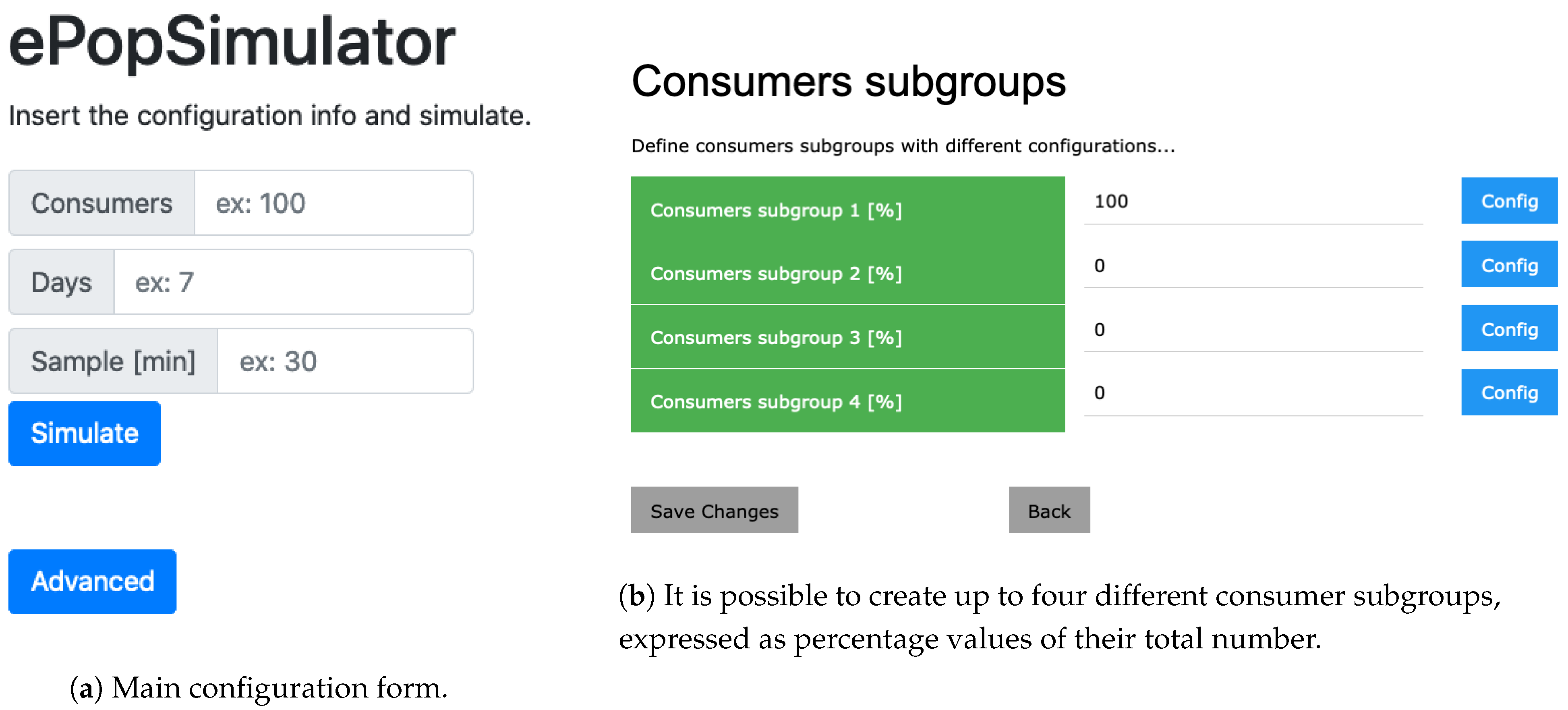
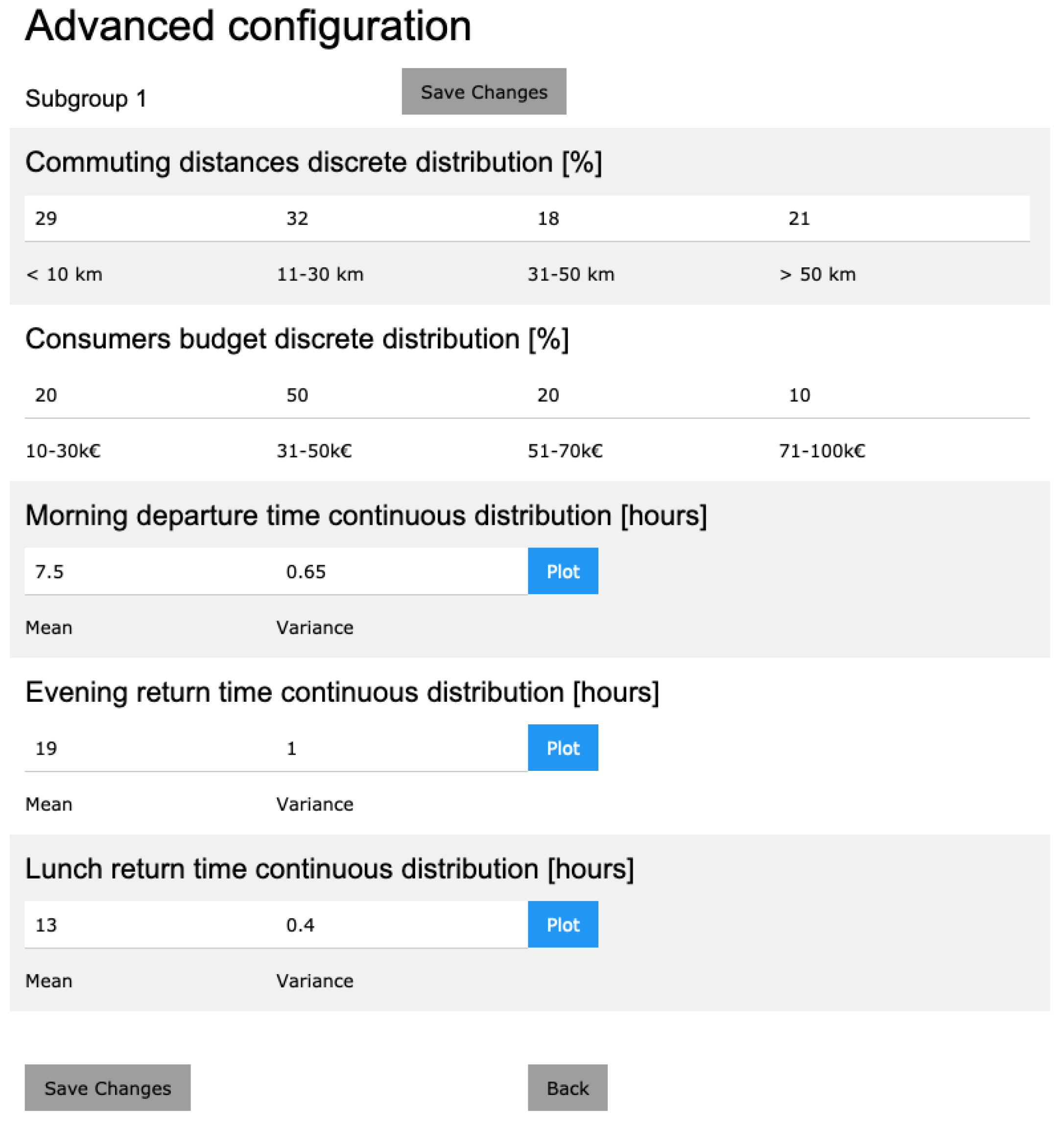
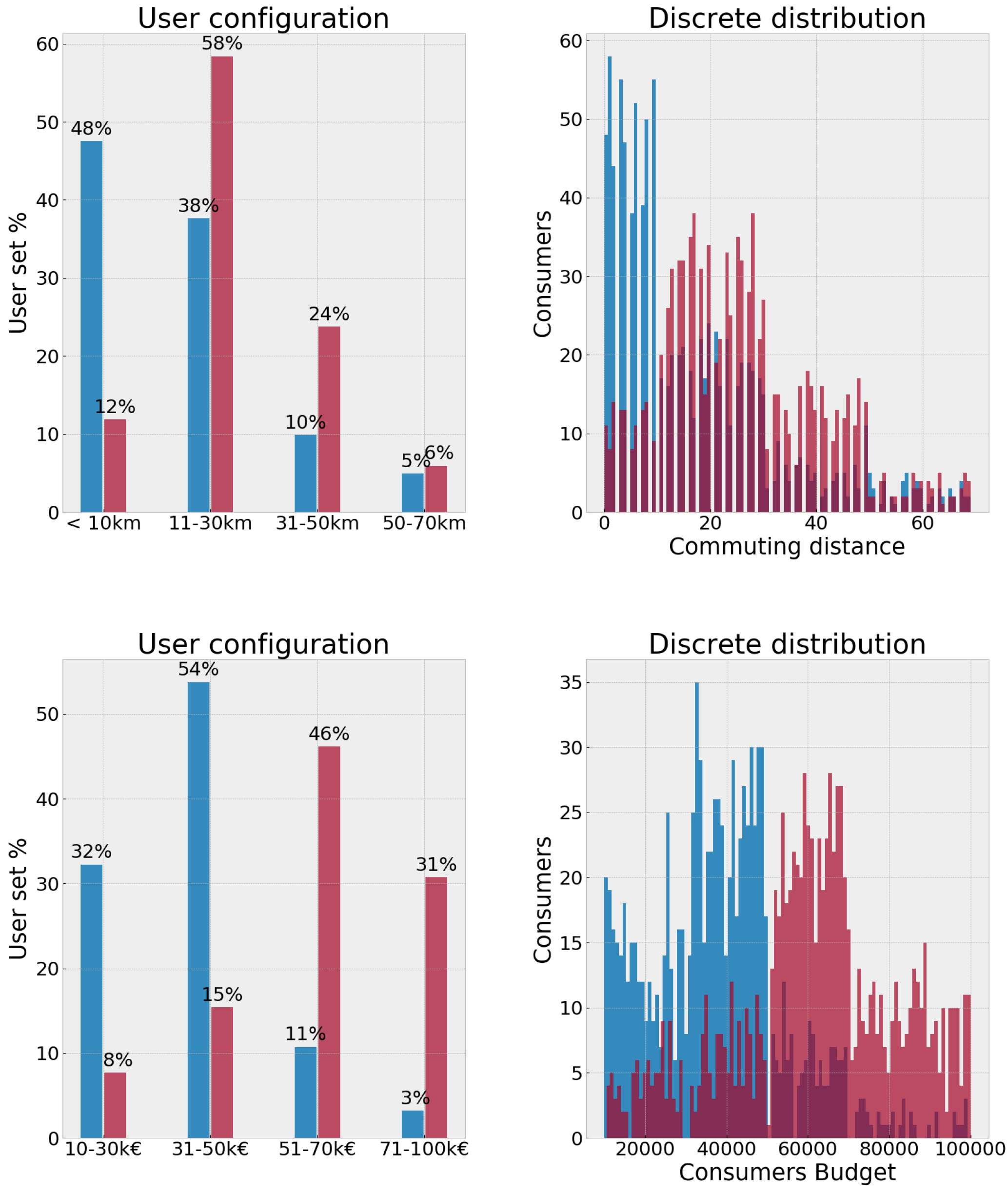
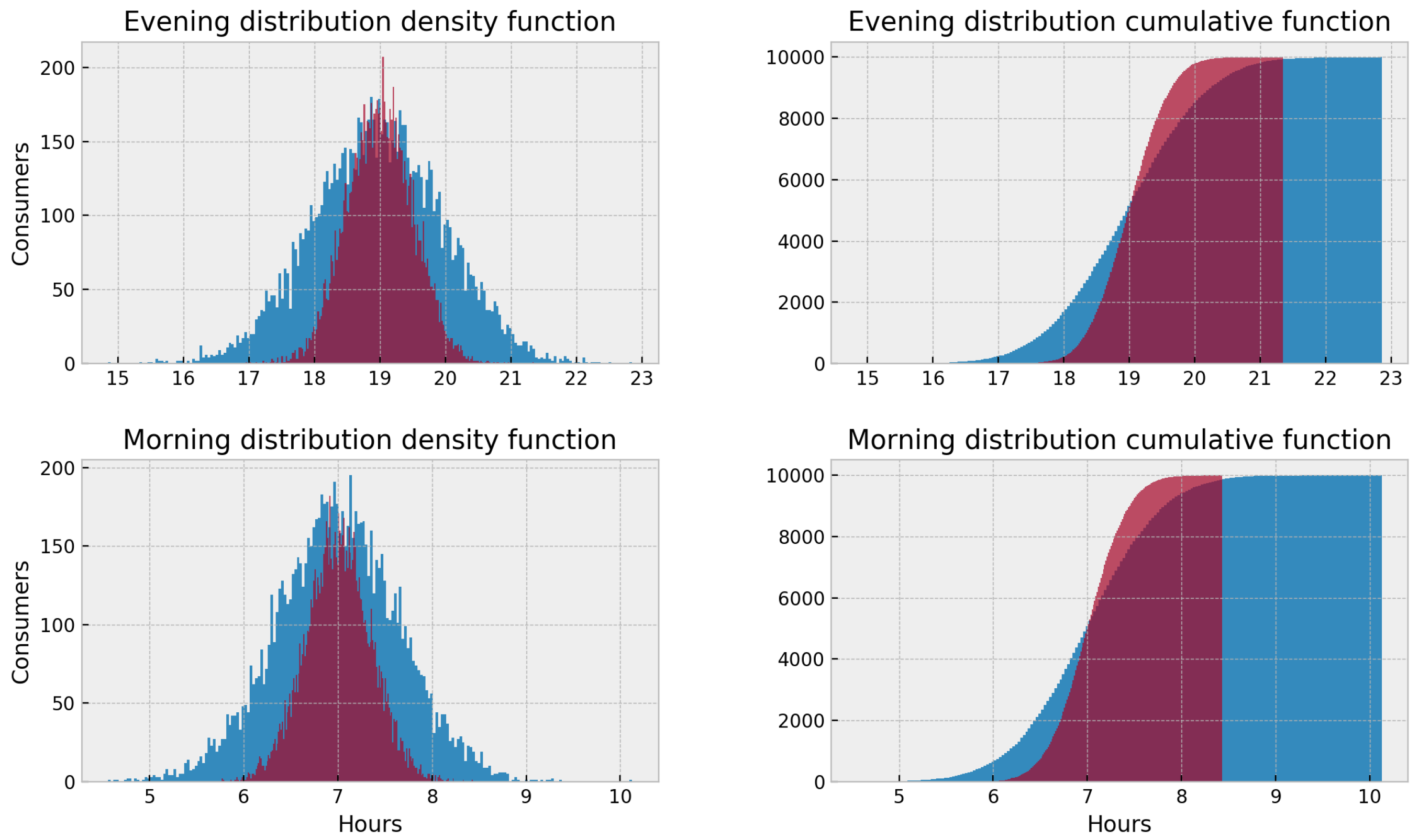
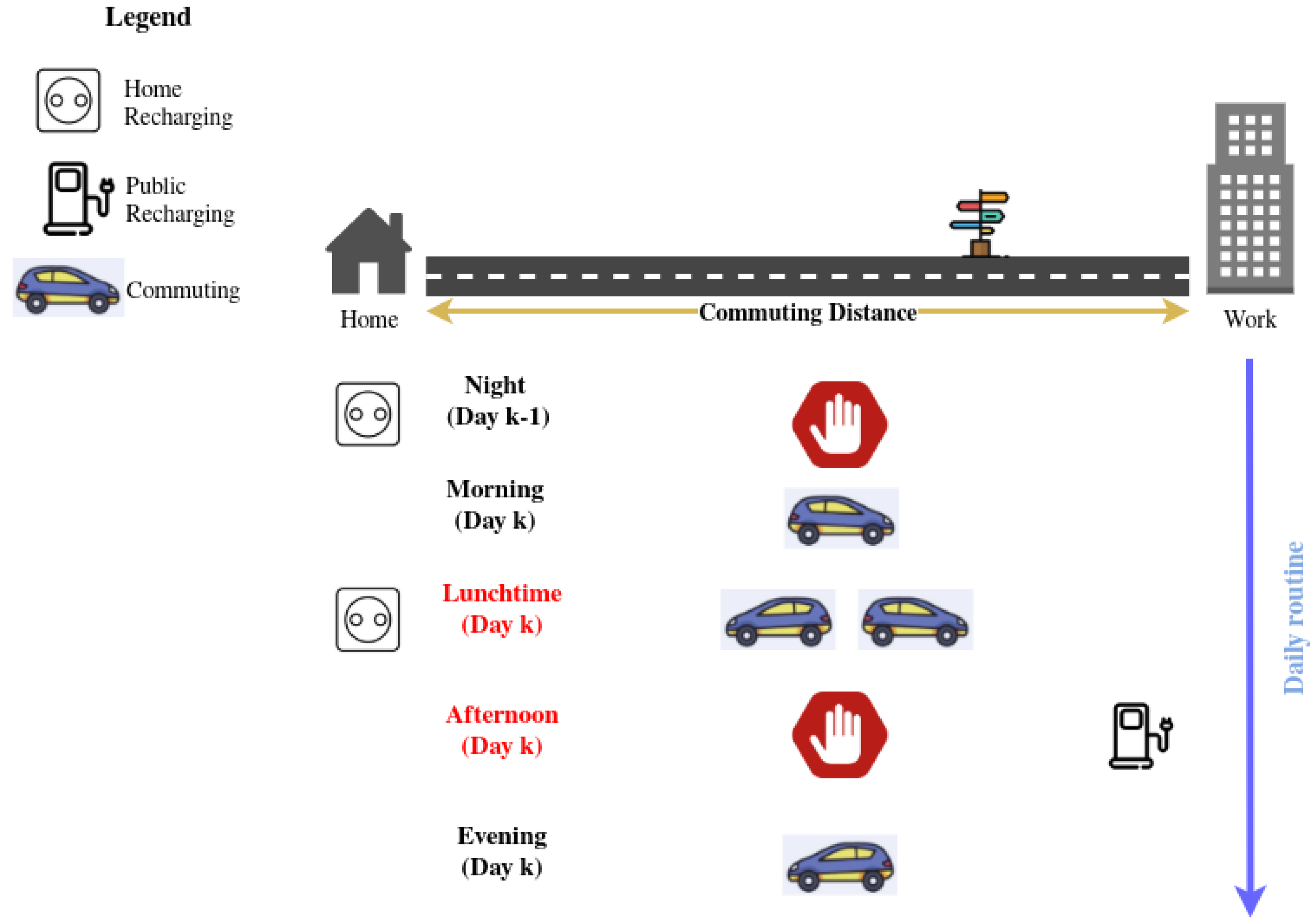

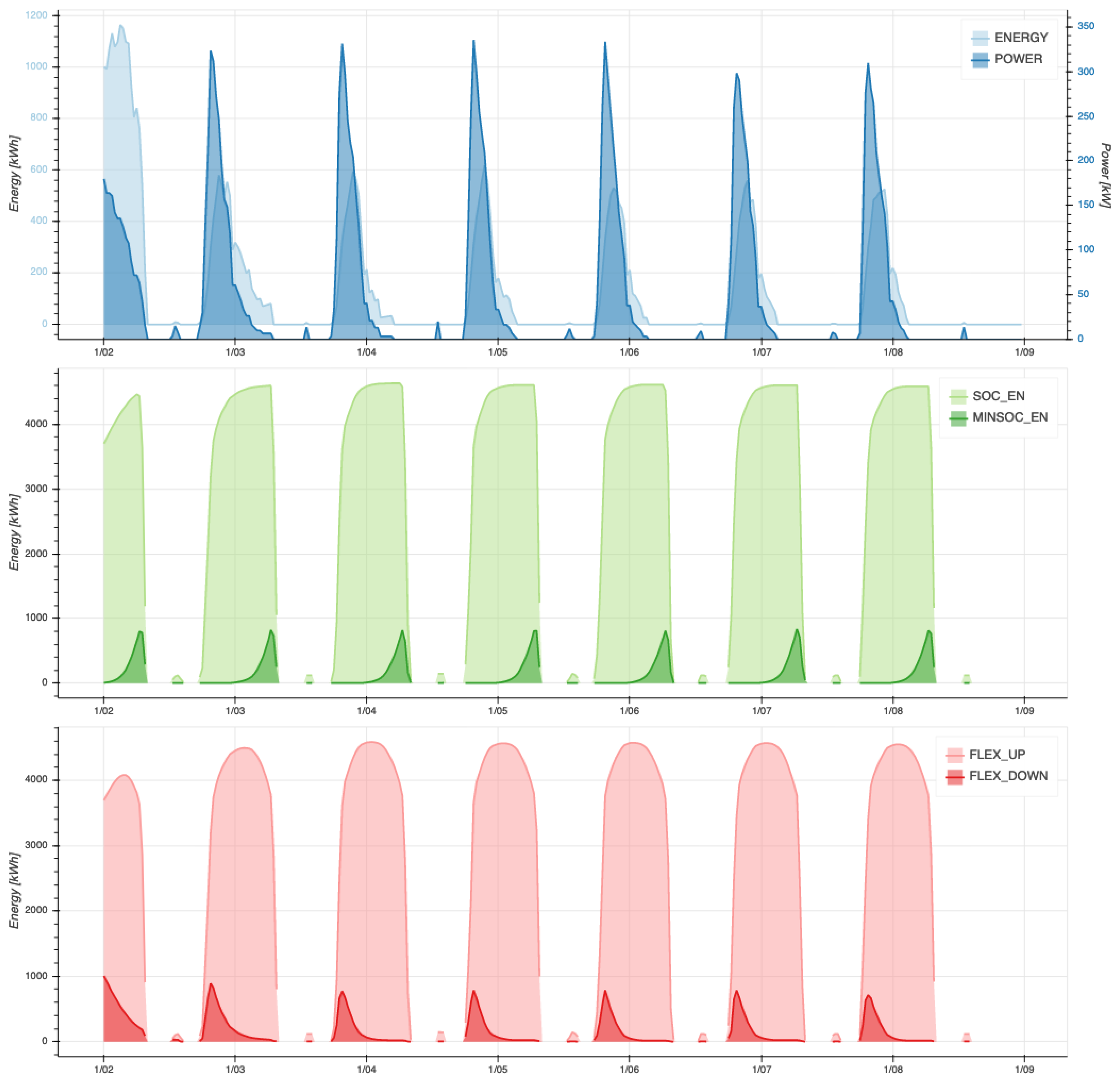
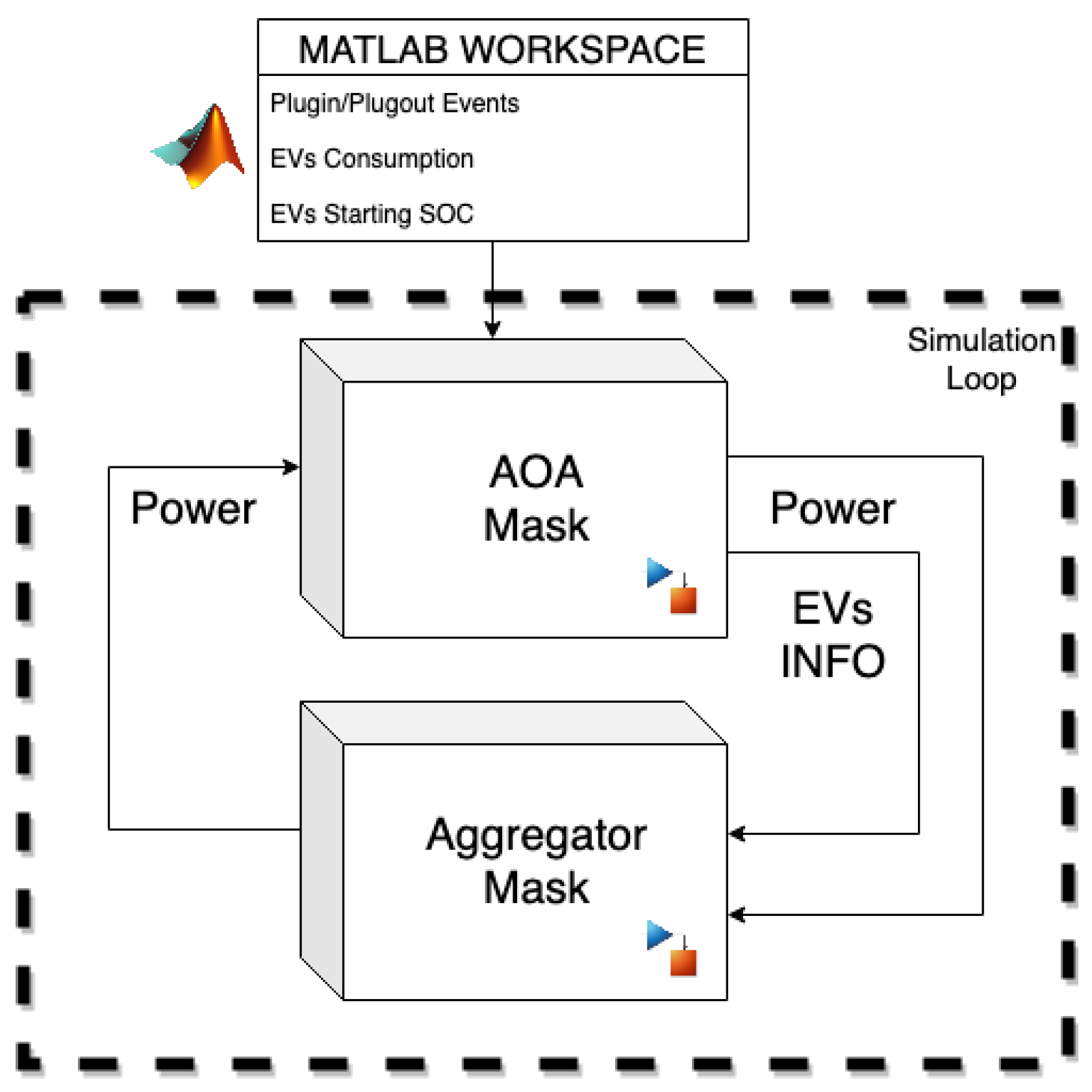
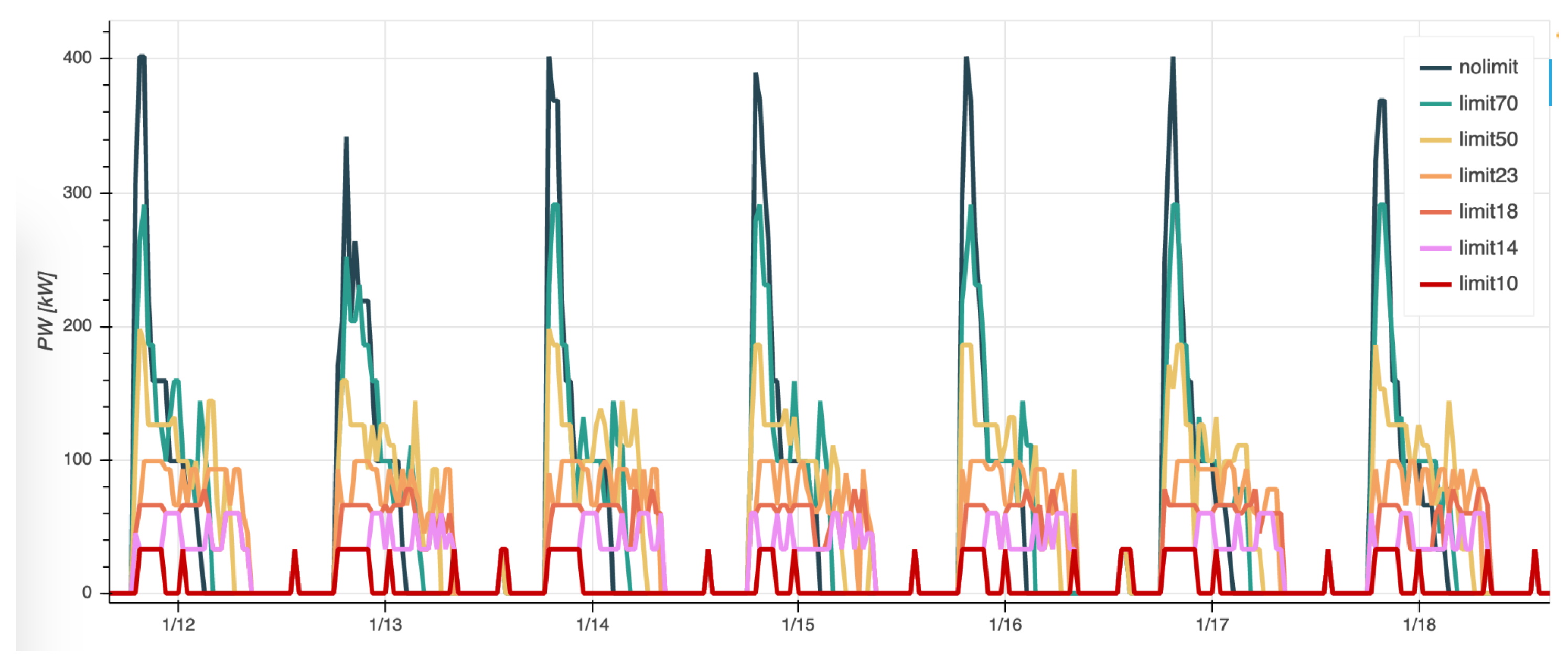
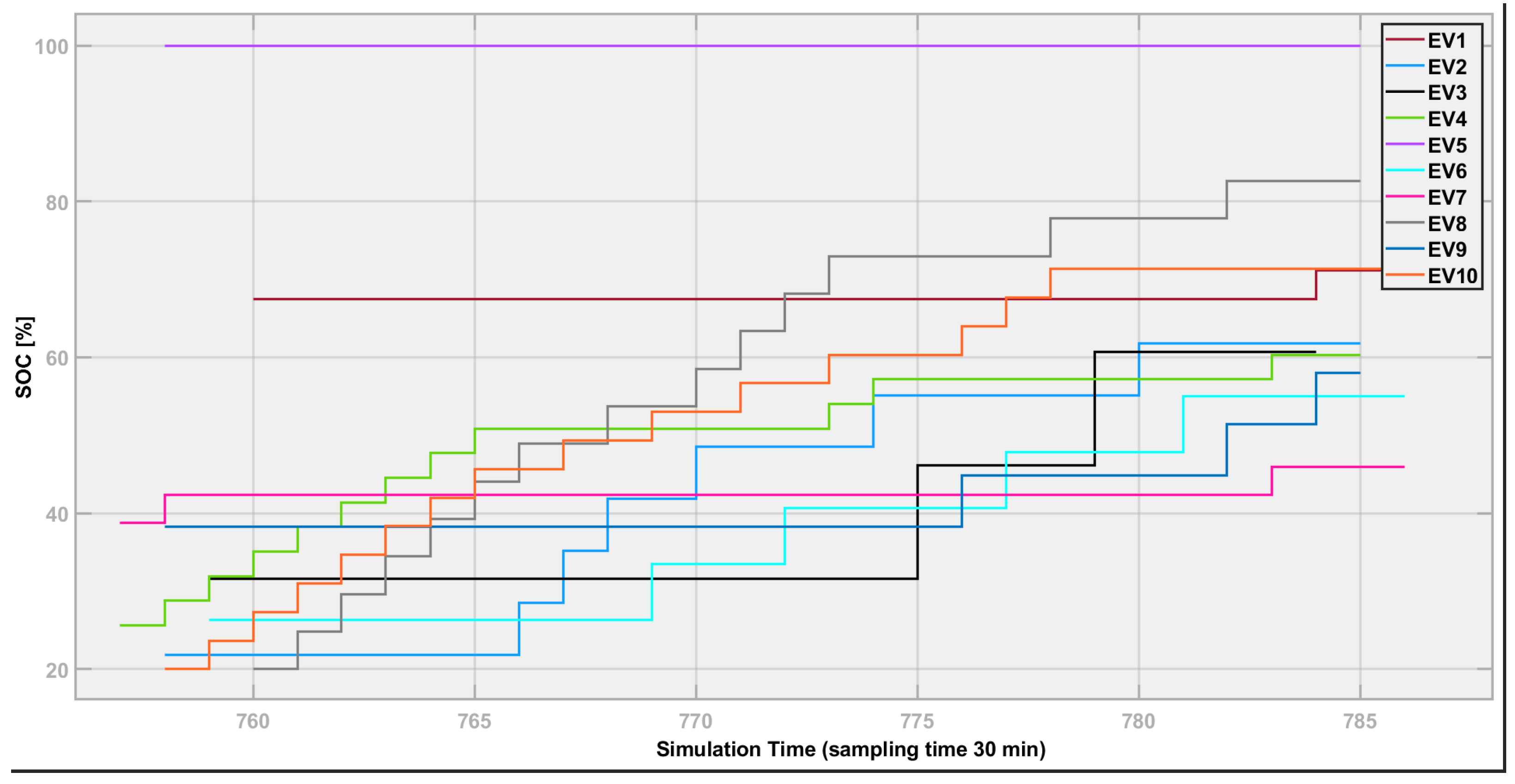
| Citation | Vehicle Type | Vehicle Modeling | Price Driven Vehicle Choice | Plug-In/-Out Scheduling | Customer Daily Routine Modeling | Daily Charge Data Generation | Traffic/Trip Simulation | Home Recharging | Public Station Recharging | Simulator (Language) |
|---|---|---|---|---|---|---|---|---|---|---|
| Present work | EV, Hybrid | Yes | Yes | Yes | Yes | Yes (1,10,15,30) minutes resolution | Yes | Yes | Yes | Custom (Python, Matlab) |
| [13] | EV | Partial | No | No | Partial | No | No | Yes | Yes | Custom (R - RStudio) |
| [14] | EV | Yes | No | No | No | No | No | No | Yes | EVLibSim (Java) |
| [15] | EV, Hybrid | Yes (autonomy estimation) | No | No | No | No | Yes | No | Yes | Custom (Matlab/Simulink) |
| [16] | EV | Partial | No | Partial | Partial | Yes | Yes | No | Yes | Omnet++, SUMO, VEINS |
| [17] | EV + CO | No | No | No | Partial (Statistical) | No | Yes | No | No | MATSim, EnergyPLAN |
| [18] | EV | No | No | No | Partial | Yes | Yes | Yes | Yes | DER-CAM |
| [19] | EV | Yes (Battery model) | No | No | No | Partial | No | No | Yes | Custom (Matlab/Simulink) |
| [20] | EV | Yes | No | Yes | Yes | Yes | No | Yes | No | Custom |
| [21] | EV | Yes | No | No | Yes | Yes | No | Yes | No | JADE |
| Input Variables | Linguistic Terms | Fuzzy Sets () |
|---|---|---|
| ChargeRequisite [%] | Negative | −100, −100, −20, 0 |
| Zero | −20, 0, 0, 10 | |
| Lightly positive | 0, 10, 20, 30 | |
| Positive | 10, 30, 100, 100 | |
| RechAvailability [%] | Low | 0, 0, 30, 45 |
| Medium | 30, 45, 60, 75 | |
| High | 60, 75, 100, 100 | |
| SOC [%] | Low | 0, 0, 30, 40 |
| Medium | 30, 40, 60, 70 | |
| High | 60, 70, 100, 100 | |
| Output Variable | Linguistic Terms | Fuzzy Sets (Value) |
| Priority | Null | 0 |
| Low | 0.4 | |
| Medium | 0.6 | |
| High | 0.8 | |
| Absolute | 1 |
| % | Buff-Mean (%) | Buff-Median (%) | Buff-Min (%) | Buff-Max (%) | Buff-Perc (%) | PW-Max (kW) |
|---|---|---|---|---|---|---|
| Test | ||||||
| nolimit | 66.8 | 66.2 | 9.8 | 97.9 | 100.0 | 435 |
| limit70 | 66.8 | 66.2 | 5.2 | 97.9 | 100.0 | 297 |
| limit50 | 61.4 | 54.3 | 4.9 | 97.9 | 100.0 | 198 |
| limit23 | 30.2 | 17.8 | −13.3 | 97.9 | 80.3 | 99 |
| limit18 | 11.4 | −4.9 | −37.8 | 97.9 | 32.2 | 78 |
| limit14 | 2.9 | −9.3 | −60.8 | 97.9 | 24.7 | 60 |
| limit10 | −9.2 | −26.5 | −85.2 | 97.9 | 23.4 | 33 |
Publisher’s Note: MDPI stays neutral with regard to jurisdictional claims in published maps and institutional affiliations. |
© 2021 by the authors. Licensee MDPI, Basel, Switzerland. This article is an open access article distributed under the terms and conditions of the Creative Commons Attribution (CC BY) license (http://creativecommons.org/licenses/by/4.0/).
Share and Cite
Ciabattoni, L.; Cardarelli, S.; Somma, M.D.; Graditi, G.; Comodi, G. A Novel Open-Source Simulator Of Electric Vehicles in a Demand-Side Management Scenario. Energies 2021, 14, 1558. https://doi.org/10.3390/en14061558
Ciabattoni L, Cardarelli S, Somma MD, Graditi G, Comodi G. A Novel Open-Source Simulator Of Electric Vehicles in a Demand-Side Management Scenario. Energies. 2021; 14(6):1558. https://doi.org/10.3390/en14061558
Chicago/Turabian StyleCiabattoni, Lucio, Stefano Cardarelli, Marialaura Di Somma, Giorgio Graditi, and Gabriele Comodi. 2021. "A Novel Open-Source Simulator Of Electric Vehicles in a Demand-Side Management Scenario" Energies 14, no. 6: 1558. https://doi.org/10.3390/en14061558
APA StyleCiabattoni, L., Cardarelli, S., Somma, M. D., Graditi, G., & Comodi, G. (2021). A Novel Open-Source Simulator Of Electric Vehicles in a Demand-Side Management Scenario. Energies, 14(6), 1558. https://doi.org/10.3390/en14061558










